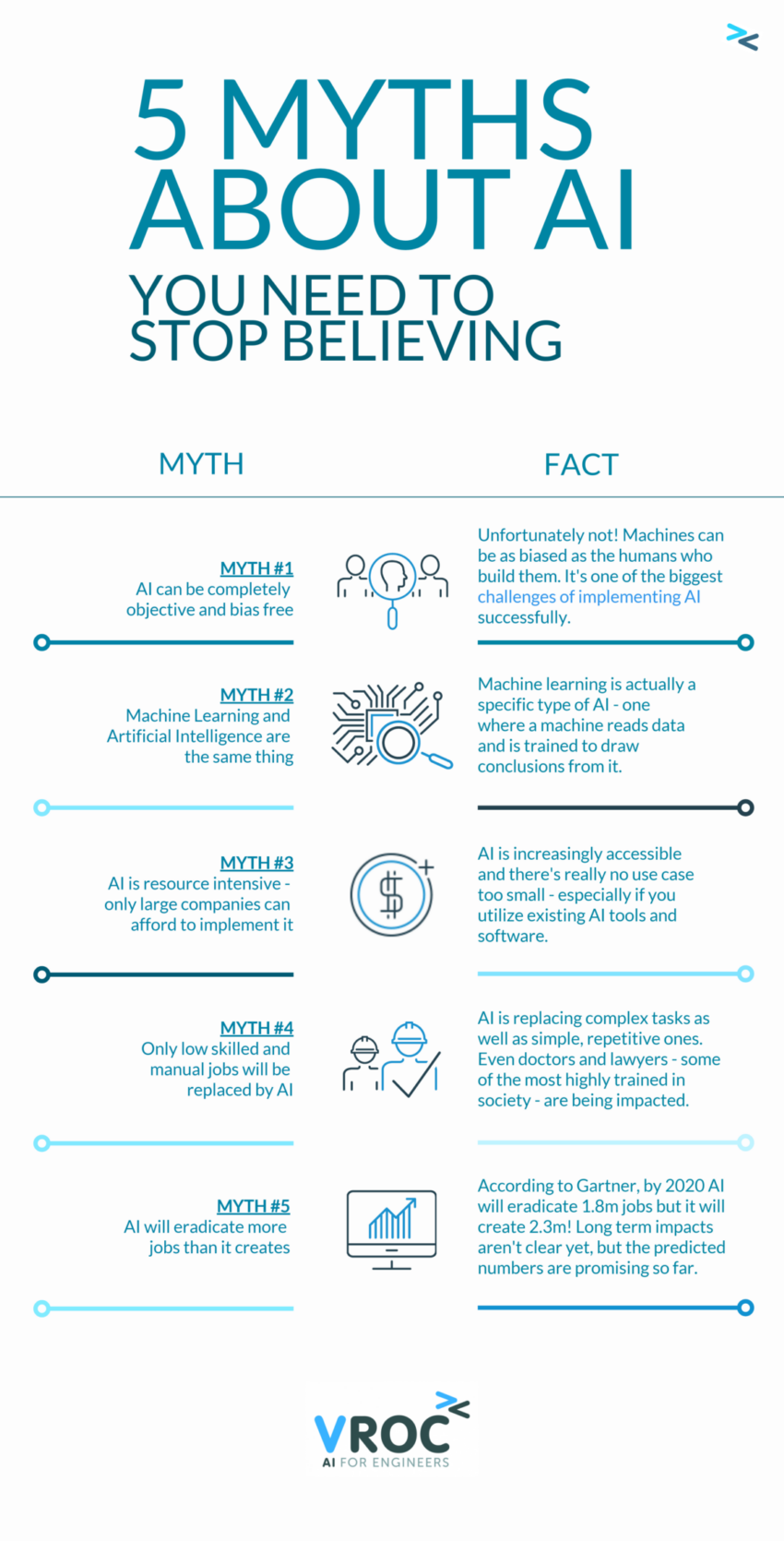Demystifying Common Myths About AI and Machine Learning

Introduction
Artificial Intelligence (AI) and Machine Learning (ML) have become buzzwords in today’s technology-driven world. However, there are several misconceptions and myths surrounding these fields that often lead to confusion and misunderstanding. In this blog post, we aim to demystify some of the common myths about AI and ML, providing a clearer understanding of their capabilities and limitations.
AI and Machine Learning are the Same
Contrary to popular belief, AI and machine learning are not interchangeable terms. While AI refers to the broader concept of machines performing tasks that would typically require human intelligence, machine learning is a subset of AI that focuses on enabling machines to learn from data and improve their performance without explicit programming.
AI Will Replace Human Jobs
One of the most common fears surrounding AI is that it will lead to widespread job loss. While AI and machine learning can automate certain tasks, they are designed to augment human capabilities rather than replace humans entirely. These technologies are more likely to create new job opportunities and enhance productivity in various industries.
AI is Only for Tech Companies
AI and machine learning have applications across diverse industries, not just limited to tech companies. From healthcare and finance to agriculture and transportation, AI can be utilized to improve efficiency, make better predictions, and enhance decision-making processes. The potential of AI extends far beyond the tech sector.
AI is Infallible
While AI and machine learning algorithms can process vast amounts of data and make accurate predictions, they are not infallible. These technologies are only as good as the data they are trained on. Biases in data or incorrect assumptions can lead to flawed outcomes. It is crucial to continuously monitor and evaluate AI systems to ensure their reliability and fairness.
AI is a Recent Invention
AI may seem like a recent development, but its roots can be traced back to the 1950s. The term “”artificial intelligence”” was coined in 1956, and since then, researchers and scientists have been working on various AI techniques. While recent advancements have accelerated the adoption of AI, the concept itself has been around for decades.
AI Will Take Over the World
AI taking over the world is a common theme in science fiction, but it remains a myth. AI systems are designed to perform specific tasks and lack the general intelligence and consciousness possessed by humans.
Summary
AI and ML are often portrayed in popular media as all-powerful technologies capable of human-like intelligence and decision-making. However, it is important to separate fact from fiction and understand the true nature of these technologies.
One common myth is that AI and ML can replace human jobs entirely. While it is true that automation can streamline certain tasks, AI and ML are more effective when used in collaboration with human expertise. They can augment human capabilities, enabling us to make better decisions and solve complex problems.
Another myth is that AI and ML algorithms are infallible and unbiased. In reality, these algorithms are only as good as the data they are trained on. If the training data is biased or incomplete, the algorithms can perpetuate and amplify those biases. It is crucial to ensure that AI and ML systems are designed and trained with diverse and representative datasets to mitigate bias.
Furthermore, AI and ML are not magical solutions that can solve all problems instantly. They require careful planning, data preparation, and continuous monitoring to deliver accurate and reliable results. It is essential to set realistic expectations and understand that AI and ML are tools that require human guidance and oversight.
By debunking these myths and gaining a better understanding of AI and ML, we can harness their potential while avoiding unrealistic expectations. These technolo webpage gies have the power to revolutionize various industries and improve our lives, but it is important to approach them with a balanced perspective.
- Q: Is AI the same as Machine Learning?
- A: No, AI and Machine Learning are related but not the same. AI is a broader concept that refers to machines performing tasks that require human intelligence. Machine Learning is a subset of AI that focuses on algorithms and statistical models to enable machines to learn and make predictions.
- Q: Can AI and Machine Learning replace human jobs?
- A: While AI and Machine Learning can automate certain tasks, they are not designed to replace humans entirely. Instead, they aim to augment human capabilities, improve efficiency, and enable humans to focus on more complex and creative tasks.
- Q: Is AI only useful for large corporations?
- A: No, AI and Machine Learning have applications across various industries and can benefit businesses of all sizes. From healthcare and finance to retail and manufacturing, organizations can leverage AI to enhance decision-making, optimize processes, and improve customer experiences.
- Q: Does AI always require big data?
- A: While having large amounts of data can be beneficial for training AI models, it is not always a requirement. AI algorithms can still provide valuable insights and perform tasks with smaller datasets. The key is to ensure the data used is representative and relevant to the problem at hand.
- Q: Will AI and Machine Learning make humans obsolete?
- A: No, AI and Machine Learning are designed to work alongside humans, not replace them. They excel at handling repetitive tasks, analyzing vast amounts of data, and making predictions. However, human judgment, creativity, and empathy remain crucial for decision-making and complex problem-solving.

Hello, I’m Brayden Denman, a passionate and experienced Mobile App Developer specializing in Cloud Computing, Software Development, Mobile App Integration, and AI & Machine Learning. With a strong background in these fields, I strive to create innovative and user-friendly solutions that meet the ever-evolving needs of businesses and individuals.
Introduction Artificial Intelligence (AI) and Machine Learning (ML) have become buzzwords in today’s technology-driven world. However, there are several misconceptions and myths surrounding these fields that often lead to confusion and misunderstanding. In this blog post, we aim to demystify some of the common myths about AI and ML, providing a clearer understanding of their…

Hello, I’m Brayden Denman, a passionate and experienced Mobile App Developer specializing in Cloud Computing, Software Development, Mobile App Integration, and AI & Machine Learning. With a strong background in these fields, I strive to create innovative and user-friendly solutions that meet the ever-evolving needs of businesses and individuals. Read More.
Recent Posts
- Challenges in Cross-Platform Digital Asset Search and Retrieval
- The Role of AI in Enhancing Digital Asset Retrieval
- Implementing Automation in Digital Asset Recovery Processes
- Digital Asset Retrieval: Addressing Security and Privacy Concerns
- Optimizing Metadata for Quicker Digital Asset Discovery
- Overcoming Barriers in Searching and Accessing Digital Assets
- Best Practices for Efficient Digital Asset Retrieval
- Harnessing the Power of Deep Learning: A Beginner’s Guide
- Scalability Issues in Large-Scale Machine Learning Projects
- Navigating the Ethical Challenges of AI Implementations
